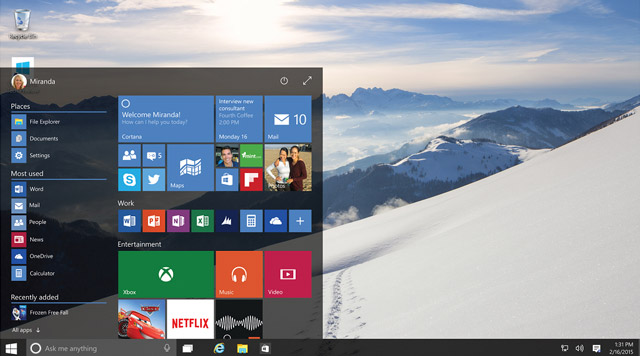 It was expected to be a fairly routine keynote address, with Microsoft using an event in Seattle on Wednesday to take the wraps off the consumer features of its new operating system, Windows 10. What it turned into was arguably the most exciting technology industry keynote address since Steve Jobs took to a stage in 2007 to introduce the iPhone to the world.
It was expected to be a fairly routine keynote address, with Microsoft using an event in Seattle on Wednesday to take the wraps off the consumer features of its new operating system, Windows 10. What it turned into was arguably the most exciting technology industry keynote address since Steve Jobs took to a stage in 2007 to introduce the iPhone to the world.
Much of the early focus of the keynote was indeed on Windows 10, which is expected to debut later this year, so let’s deal with that first.
Perhaps the biggest surprise about the new software is that it will be free (for a year) for those running Windows 7 and Windows 8.1. The same software will run across desktops, laptops, tablets and smartphones — the Windows Phone name is being abandoned in favour of a uniform “Windows 10” across all device categories.
Less surprising is the news that it will come with a new lightweight Web browser — code-named Project Spartan — as Microsoft seeks to recover market share lost to rivals, especially Google, by building an alternative to the much-maligned Internet Explorer. Cortana, Microsoft’s equivalent of Apple’s Siri intelligent personal voice assistant, will be built into Spartan and into Windows 10.
Windows 10 is impressive-looking software. Where Windows 8/8.1 felt like a kludge, the new operating system adapts itself intuitively to the hardware it’s running on.
There was plenty of other Windows news that flowed at Wednesday’s event — so-called universal applications designed for Windows will also run on the Xbox One gaming console, for example, and there was more information on how the newly reinstated start menu will function — but this was all overshadowed in the final third of the event.
That’s when the company’s Alex Kipman took to the stage to unveil Windows Holographic augmented reality (AR) technology, which will form a cornerstone of Windows 10 and which Microsoft believes will set the foundation for the future of human-machine interaction.
The first hardware based on Windows Holographic is the HoloLens wireless AR headgear that resembles something straight out of science-fiction. The HoloLens blends holograms into reality through the transparent lenses on the headgear. Microsoft says the HoloLens “intelligently maps” the room the wearer is in, “blending holograms with the environment”. Users can “pin holograms to physical locations” they choose so that the room they’re in becomes the “canvas” for their holographic projects and games. And it’s powered by movement, vision and voice through a special “holographic processing unit”.
Words can’t do the technology justice: I strongly recommend looking at YouTube for demonstration videos. Then imagine it being used for gaming, or for video conferencing.

At the very least, Microsoft has leapt ahead of the competition. Google Glass, Google’s attempt at augmented reality, now looks hopelessly dated. And the HoloLens is far less dorky and appears to be much more practical that the Oculus Rift virtual reality goggles from Oculus VR, recently acquired by Facebook for US$2bn.
The HoloLens and the Windows Holographic software are important not just because they’re innovative, they also symbolise a fundamental change under way at Microsoft.
The company, which in the eyes of many consumers had become boring, is now in real danger of becoming cool again, of becoming a leader instead of a laggard.
The foundation for this change was set under former CEO Steve Ballmer, who often doesn’t get the credit he deserves. But his successor, Satya Nadella, is accelerating the change in the company’s corporate culture, putting innovation at the centre of what it does.
HoloLens could yet fail, the same way Google Glass did. Are people going to be okay with wearing headsets to interact with computers, even if the hardware is comfortable and lightweight? Or will computing be driven in other directions?
What’s exciting is that Microsoft has not only decided it’s time to find out, but it has quickly sprinted to the front of the race.
- Duncan McLeod is editor of TechCentral. Find him on Twitter
- This column was first published in the Sunday Times

